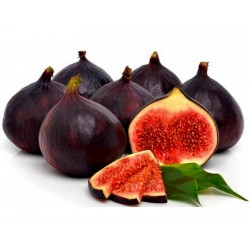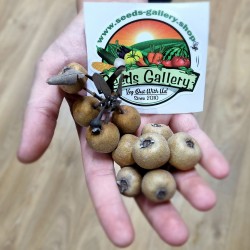Seeds Gallery Com,
5/
5
<h2><strong>Kalamata Olive tree seeds Greece variety (Olea europaea)</strong></h2>
<h2><span style="color: #ff0000;"><strong>Price for Package of 5 or 10 seeds.</strong></span></h2>
<p><strong>Why do we say that this olive is resistant to winter?</strong><br><strong>This olive, which we ourselves have and grow in a large flower pot, has been surviving outdoors (in the yard) for four years now without any problems with winter and at temperatures of -15 degrees Celsius.</strong><br><br><strong>We believe that it would even survive temperatures down to - 25 degrees Celsius, and maybe more ...</strong><br><br><span style="color: #202122; font-size: 14px;">The<span> </span></span><b style="color: #202122; font-size: 14px;">Kalamata olive</b><span style="color: #202122; font-size: 14px;"><span> </span>is a large, dark brown<span> </span></span>olive<span style="color: #202122; font-size: 14px;"><span> </span>with a smooth, meaty texture, named after the city of<span> </span></span>Kalamata<span style="color: #202122; font-size: 14px;"><span> </span>in the southern<span> </span></span>Peloponnese<span style="color: #202122; font-size: 14px;">,<span> </span></span>Greece<span style="color: #202122; font-size: 14px;">.</span><sup id="cite_ref-lonely_2-0" class="reference" style="color: #202122; font-size: 11.2px;">[2]</sup><span style="color: #202122; font-size: 14px;"><span> </span>Often used as table olives, they are usually preserved in wine vinegar or olive oil. Typically the term "Kalamata" legally refers to a region of Greece where these olives are grown, however a few countries (those mainly outside the United States and European Union) use the name for such olives grown anywhere, even outside of Greece. Within the EU (and other countries that ratified PDO agreements or similar laws) the name is protected with<span> </span></span>PDO<span style="color: #202122; font-size: 14px;"><span> </span>status, which means that the name can only be used for olives (and olive oil) from the region around Kalamata.</span><sup id="cite_ref-3" class="reference" style="color: #202122; font-size: 11.2px;">[3]</sup><span style="color: #202122; font-size: 14px;"><span> </span>Olives of the same variety grown elsewhere are marketed as<span> </span></span><b style="color: #202122; font-size: 14px;">Kalamon olives</b><span style="color: #202122; font-size: 14px;"><span> </span>in the EU and, sometimes, elsewhere.</span></p>
<h2 style="color: #000000; font-size: 1.5em;"><span class="mw-headline" id="Description">Description</span></h2>
<p style="color: #202122; font-size: 14px;">Kalamata olives are so-named because they were originally grown in the region around Kalamata, which includes<span> </span>Messenia<span> </span>and nearby<span> </span>Laconia, both located on the Peloponnese peninsula. They are now grown in many places around the world, including in the<span> </span>United States<span> </span>and<span> </span>Australia. They are almond-shaped, plump, dark purple olives<sup id="cite_ref-sophisticated_9-0" class="reference" style="font-size: 11.2px;">[9]</sup><span> </span>from a tree distinguished from the common<span> </span>olive<span> </span>by the size of its leaves, which grow to twice the size of other olive varieties.<sup id="cite_ref-lonely_2-1" class="reference" style="font-size: 11.2px;">[2]</sup><span> </span>The trees are intolerant of cold and are susceptible to<span> </span><i>Verticillium</i><span> </span>wilt<span> </span>but are resistant to<span> </span>olive knot<span> </span>and to the<span> </span>olive fruit fly.<sup id="cite_ref-10" class="reference" style="font-size: 11.2px;">[10]</sup></p>
<p style="color: #202122; font-size: 14px;">Kalamata olives, which cannot be harvested green, must be hand-picked in order to avoid bruising. They are classed as black olives.<br><br></p>
<h2 style="color: #000000; font-size: 1.5em;"><span class="mw-headline" id="Synonyms">Synonyms</span></h2>
<p><i>Aetonychalea</i>:<span> </span>Kalamata (old: Kalámai);<br><i>Aetonychi</i>: Greece;<br><i>Aetonycholia</i>: Kalamata,<span> </span>Patras;<br><i>Calamata</i>:<span> </span>Agrínio,<span> </span>Aitoliko,<span> </span>Cyprus,<span> </span>Iznik, Kalamata,<span> </span>Lakonia,<span> </span>Messini,<span> </span>Peloponnese,<span> </span>Sparta,<span> </span>Western Cape (South Africa),<span> </span>California (USA);<br><i>Calamatiani</i>: Greece;<br><i>Calamon</i>: California, Kalamata,<span> </span>Crete, Lakonia,<span> </span>Lamia, Messini, Patras, Peloponnese,<span> </span>Tunisia,<span> </span>Western Australia;<br><i>Chondrolia</i>: Kalamata, Lakonia, Messini, Patras;<br><i>Kalamata Jumbo</i><span> </span>and<span> </span><i>Kalamata Tiny</i>: Western Australia;<br><i>Kalamatiani</i>: Peloponnese;<br><i>Kalamon</i>: Greece,<span> </span>China,<span> </span>Cyprus, Crete, Peloponnese,<span> </span>Perugia (Italy),<span> </span>South Africa;<br><i>Karakolia</i>: Greece;<br><i>Nychati</i>: Kalamata, Peloponnese;<br><i>Nychati di Kalamata</i>: Aitoliko, Kalamata, Lakonia;<br><i>Tsigeli</i>: Greece;<br><i>Karamursel Su Kalamata</i>:<span> </span>Bursa,<span> </span>Gebze, Gölcük,<span> </span>Karamürsel,<span> </span>Kocaeli, the Marmara region;<br><i>Su Zeytini</i><span> </span>(Turkey).<sup id="cite_ref-11" class="reference" style="font-size: 11.2px;"></sup></p>
<h2 style="color: #000000; font-size: 1.5em;"><span class="mw-headline" id="Preparation">Preparation</span></h2>
<p>There are two methods of preparing Kalamata olives, known as the long and short methods. The short method debitters the olives by packing them in water or weak<span> </span>brine, which is changed daily, for around a week. Once debittered, they are then packed in brine and wine<span> </span>vinegar<span> </span>with a layer of<span> </span>olive oil<span> </span>and slices of<span> </span>lemon<span> </span>on top. The olives are often slit to further decrease the processing time. The long method involves slitting the olives, placing them in strong brine for up to three months in order to debitter them. Some<span> </span>polyphenol<span> </span>remains in the olives after processing, giving them their slightly bitter taste.</p>
<h2 class=""></h2>
<table border="1" cellspacing="0" cellpadding="0">
<tbody>
<tr>
<td colspan="2" valign="top" width="100%">
<p><span>Sowing Instructions</span></p>
</td>
</tr>
<tr>
<td valign="top" nowrap="nowrap">
<p><span style="white-space: normal;">Propagation:</span></p>
</td>
<td valign="top">
<p><span>Seeds / Cuttings</span></p>
</td>
</tr>
<tr>
<td valign="top" nowrap="nowrap">
<p><span style="white-space: normal;">Pretreat:</span></p>
</td>
<td valign="top">
<p><span>Break seed coat gently, without hurting the seed inside.</span></p>
</td>
</tr>
<tr>
<td valign="top" nowrap="nowrap">
<p><span style="white-space: normal;">Stratification:</span></p>
</td>
<td valign="top">
<p><span>0</span></p>
</td>
</tr>
<tr>
<td valign="top" nowrap="nowrap">
<p><span style="white-space: normal;">Sowing Time:</span></p>
</td>
<td valign="top">
<p><span>all year round</span></p>
</td>
</tr>
<tr>
<td valign="top" nowrap="nowrap">
<p><span style="white-space: normal;">Sowing Depth:</span></p>
</td>
<td valign="top">
<p><span>Light germinator! Just sprinkle on the surface of the substrate + gently press</span></p>
</td>
</tr>
<tr>
<td valign="top" nowrap="nowrap">
<p><span style="white-space: normal;">Sowing Mix:</span></p>
</td>
<td valign="top">
<p><span>Coir or sowing mix + sand or perlite</span></p>
</td>
</tr>
<tr>
<td valign="top" nowrap="nowrap">
<p><span style="white-space: normal;">Germination temperature:</span></p>
</td>
<td valign="top">
<p><span> about 20-25 ° C</span></p>
</td>
</tr>
<tr>
<td valign="top" nowrap="nowrap">
<p><span style="white-space: normal;">Location:</span></p>
</td>
<td valign="top">
<p><span>bright + keep constantly moist not wet</span></p>
</td>
</tr>
<tr>
<td valign="top" nowrap="nowrap">
<p><span style="white-space: normal;">Germination Time:</span></p>
</td>
<td valign="top">
<p><span> 2-4-8 Weeks</span></p>
</td>
</tr>
<tr>
<td valign="top" nowrap="nowrap">
<p><span style="white-space: normal;">Watering:</span></p>
</td>
<td valign="top">
<p><span>Water regularly during the growing season</span></p>
</td>
</tr>
<tr>
<td valign="top" nowrap="nowrap">
<p><span style="white-space: normal;"> </span></p>
</td>
<td valign="top">
<p><br><span>Copyright © 2012 Seeds Gallery All Rights Reserved.</span></p>
</td>
</tr>
</tbody>
</table>
<br>
<div>
<h2></h2>
<p></p>
</div>
<script src="//cdn.public.n1ed.com/G3OMDFLT/widgets.js"></script>
V 116 (5 S)
.png)


.png)




